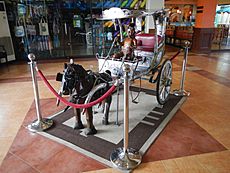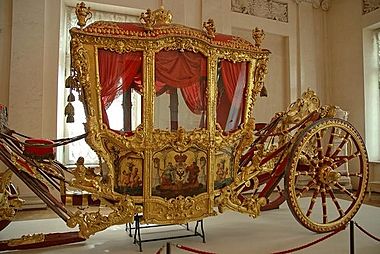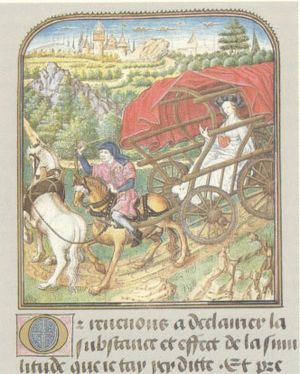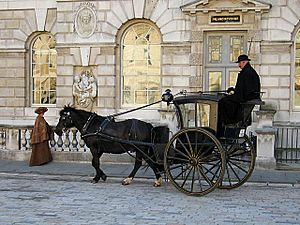Carriage facts for kids
A carriage is a vehicle with wheels, usually pulled by horses, that carries people. It's different from things like litters or sedan chairs because those don't have wheels. Carriages are mostly for private travel, but some can also carry goods. Public vehicles like stagecoaches or buses are usually not called carriages.
Carriages can be light and fast, or big and comfy. They usually have a special system called suspension to make the ride smoother. This system uses things like leaf springs or leather straps. Other wheeled vehicles, like wagons and carts, share some history with carriages, as do fast, two-wheeled chariots.
Contents
What is a Carriage?
The word carriage comes from an old French word meaning "to carry in a vehicle." The word car also came from old French and first meant a two-wheeled cart for goods. Later, it was used for railway carriages and then for automobiles (cars) around the late 1800s. Early cars were even called horseless carriages!
Sometimes, a carriage is called a team when you talk about the horse and the vehicle together. A carriage with its horse is a rig. A very fancy horse-drawn carriage with its helpers is an equipage. When you see a group of carriages moving together, it's called a cavalcade.
Carriages in History
Ancient Times
Some of the earliest hints of carriages come from Celtic graves, where horse carts might have had a basic suspension system. Four-wheeled wagons were used in Europe even before recorded history. The basic way wheels and the undercarriage were built back then is still similar to how they were made until cars became common.
The very first type of carriage we know about was the chariot. It appeared in Mesopotamia around 1900 BC. Chariots were mostly used for fighting by Egyptians and other ancient people. They were light, two-wheeled vehicles that carried one or two people and were pulled by one or two horses. Chariots were a big deal because they could quickly bring fresh fighters to important parts of a battle.
The Romans in the first century BC used wagons with suspension for long trips. It seems their carriages might have used chains or leather straps for a smoother ride, based on parts found by archaeologists. Ancient Chinese kingdoms, like those during the Warring States period, also used carriages for travel.
Medieval Carriages
During the Middle Ages, carriages were often four-wheeled wagons with a rounded top, a bit like the Conestoga wagon from the USA. They still used the same basic wheel and undercarriage design from the Bronze Age. These wagons likely had a front axle that could pivot, allowing them to turn.
Records from the 1300s show "rocking carriages" (called 'chars branlant') that had suspension using chains. By the 1400s, this was common. Carriages were mostly used by kings, queens, and rich families, especially women. They were often decorated with gold and fancy designs. These carriages usually had four wheels and needed two to four horses, depending on how heavy their decorations made them. Wood and iron were the main materials used. Carriages for regular people were usually covered with plain leather.
Another type of medieval carriage was the pageant wagon from the 1300s. These were like miniature house-like structures on four to six wheels. Pageant wagons were important because before them, most carriages had only two or three wheels. Many historians believe pageant wagons had pivotal axle systems, which let the wheels turn. This was useful because many roads were winding. Six-wheel pageant wagons were even more advanced, using multiple pivotal axles (on the front and middle wheels) to help the horses steer easily.
The Coach Innovation
A big step forward for carriages was the invention of the suspended carriage, or chariot branlant. Early versions used chains for suspension, which made the ride much smoother because the passenger area no longer sat directly on the turning axles.
In the 1400s, carriages became lighter and only needed one horse to pull them. This new design came from Hungary. Historians think people started comparing the chain-suspended chariot branlant with the light Hungarian coach. However, the first pictures of the Hungarian 'Kochi-wagon' don't show any suspension, and they often show three horses pulling it.
How Carriages Are Built
The Body of a Carriage

Carriage bodies can be closed or open. The top cover, called the head or hood, is often flexible and can be folded back, like a bellows top or calash. Thin frames called hoopsticks support this kind of hood. The top part of a closed carriage, especially a large one, was sometimes called an imperial.
Closed carriages might have side windows called quarter lights (in Britain) and windows in the doors. A "glass coach" has many windows. At the front of an open carriage, a wooden or leather screen called a dashboard stops water, mud, or snow from being splashed up by the horses. Sometimes, the dashboard or carriage top has a projecting side part called a wing. A foot iron or footplate can be used as a step to get into the carriage.
The driver of a carriage sits on a box or perch, which is usually high up. If it's at the front, it's called a dickey box. This term is also used for a small seat at the back for servants. A footman (a servant) might stand on a small platform at the back called a footboard or sit on a rumble. Some carriages have a movable seat called a jump seat. Some seats had a backrest called a lazyback.
The long poles that connect the horses to the carriage are called shafts. Lancewood, a strong and flexible wood, was often used for these shafts. A holdback is an iron catch on the shaft with a strap that helps a horse back up or hold the vehicle still. The end of the carriage's main pole is held up by a bar called the yoke, which connects to the horses' harnesses. A loop on the harness, called a cockeye, attaches to the carriage.
In some carriages, the body hangs from several leather straps called braces or thoroughbraces. These straps act like springs, making the ride smoother.
The Undergear (Wheels and Frame)
Below the carriage body is the undergear or undercarriage. This includes the wheels, axles, and the frame that supports the body. The wheels and axles are called the running gear. The wheels spin on bearings at the ends of a bar called an axle or axletree. Most carriages have one or two axles.
On a four-wheeled carriage, the front part of the running gear, or forecarriage, is designed so the front axle can turn separately from the fixed back axle. Some carriages have a 'dropped axle', which is bent near the ends. This allows the body to sit lower while still using large wheels. A guard called a dirtboard keeps dirt away from the axle.
Several parts make up the frame that supports the carriage body. The front axle and the bar above it (which holds the springs) are connected by a piece of wood or metal called a futchel. This piece holds the long pole that extends from the front axle. For extra strength, a rod called a backstay might go from the back axle to the main pole that connects the front and back axles.
A special skid called a drag, dragshoe, shoe, or skidpan can be used to slow down the wheels. A catch or block called a trigger can hold a wheel on a slope.
A flat, horizontal wheel or part of a wheel called a fifth wheel is sometimes used to help support the carriage and stop it from tipping over. It has two parts that spin on top of each other, located above the front axle and under the body. A block of wood called a headblock might be placed between the fifth wheel and the front spring.
Interesting Facts About Carriages


The person whose job was to drive a carriage was called a coachman. A servant in uniform, called a footman or piquer, used to attend to a rider or even run ahead of a master's carriage to clear the way. An attendant on horseback, called an outrider, often rode in front of or next to a carriage. A carriage starter helped direct vehicles picking up passengers at the curb. A hackneyman rented out horses and carriages. When selling goods, a hawker often used a carriage.
Wealthy people who could afford to own carriages were sometimes called carriage folk or the carriage trade.
Carriage passengers often used a lap robe as a blanket to cover their legs and feet. A buffalo robe, made from the hide of an American bison with the hair still on, was sometimes used as a carriage robe. It was usually shaped like a rectangle and lined with fabric on the skin side. A carriage boot, trimmed with fur for winter, was usually made of fabric with a fur or felt lining. A knee boot protected the knees from rain or splashes.
A horse specially trained for pulling carriages is called a carriage horse. One bred for road use is a road horse. The Cleveland Bay is a breed of horse known for being good carriage horses; they are always bay (brown with black mane and tail) and very strong. Horses were trained using a special bodiless carriage frame called a break or brake.
A carriage dog or coach dog is a type of dog bred to run alongside a carriage.
A roofed area that extends from a building's entrance over a driveway, providing shelter for people getting in or out of vehicles, is called a carriage porch or porte cochere. A building where carriages were kept is a coach house, which often had living spaces for a groom or other servants.
A livery stable was a place that kept horses and usually carriages for rent. A group of stables, often with carriage houses and living areas built around a yard, is called a mews.
A device called a peirameter can measure the power needed to pull a carriage over a road or track.
Competitive Driving
In many countries, driving a horse and carriage is a competitive sport. Many horse shows have competitions for different styles of driving, horse breeds, or types of vehicles. Show vehicles are usually carriages, carts, or buggies.
Internationally, there's a tough competition called combined driving, also known as horse-driving trials. This sport is overseen by the Fédération Équestre Internationale (FEI). World championships are held every two years for single horses, pairs of horses, and four-in-hand teams. The World Equestrian Games, held every four years, also includes a four-in-hand competition.
For pony drivers, the World Combined Pony Championships happen every two years, with events for single ponies, pairs, and four-in-hand teams.
Related pages
Images for kids
-
"The Grand Gala Berlin," a coach built in Rome for Pope Leo XII in 1824–1826. Pope Gregory XVI later asked for some changes.
-
Horse-drawn taxis for tourists in Naghsh-i Jahan Square, Esfahan.
See also
 In Spanish: Carruaje para niños
In Spanish: Carruaje para niños












